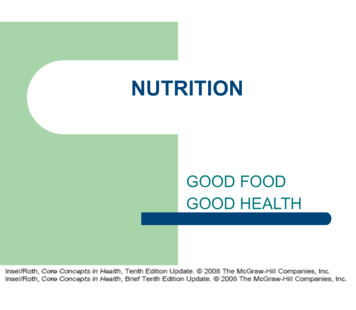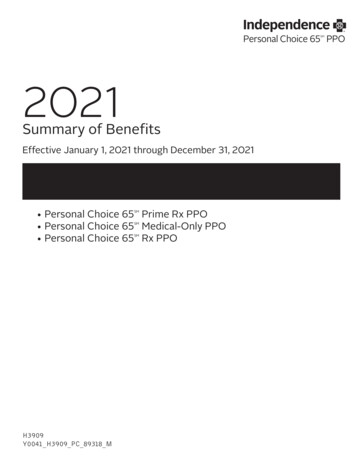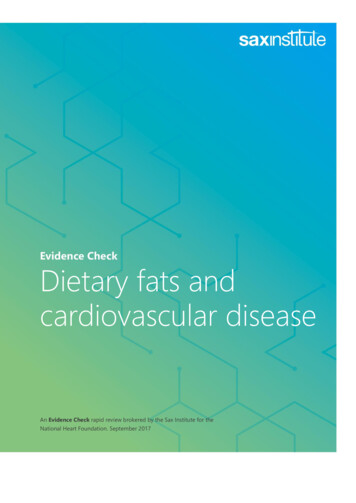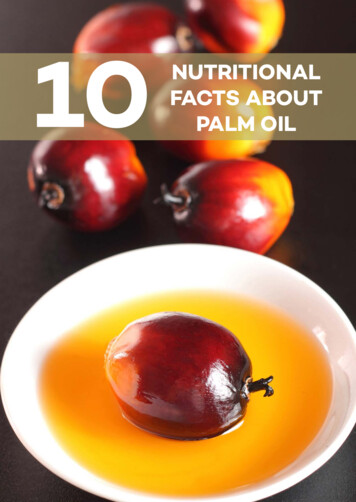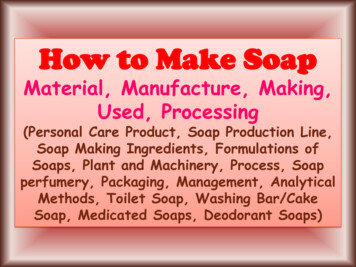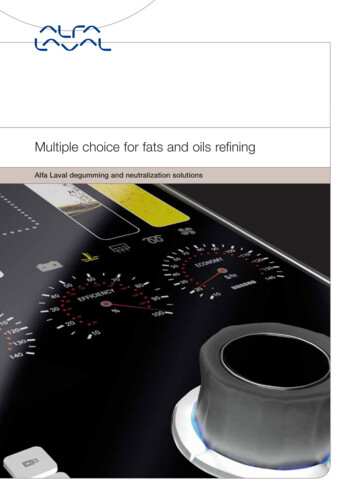
Transcription
Multiple choice for fats and oils refiningAlfa Laval degumming and neutralization solutions
Crude fats and oils always contain impuritiesthat have to be removed – and there is agrowing focus on the environmentalparameters for how you do it.Alfa Laval degumming and neutralizationequipment is designed to work with virtuallyall types of fats and oils, making it one ofthe most efficient and flexible ways to purifythem, minimizing processing lossand maximizing quality.
Make the best startDealing with impuritiesMost crude fats and oils containimpurities that must be removedearly on so that further processingcan take place.These impurities can include: solid particles (such as dirt) gums free fatty acids pigments substances that affect smelland taste.The one single technology that playsthe most important role in removingsuch impurities from both animal andvegetable fats and oils is separation.Separation is crucial in ensuring thedesired product quality, and the way itis done must comply with increasinglystringent environmental regulationsthroughout the world.Your advantage here is that Alfa Lavalis one of the world’s leading suppliersof separation equipment of virtuallyall kinds, with more than a centuryof experience in this field.Flexible responseAlfa Laval degumming andneutralization equipment is designedto ensure you maximum flexibility inyour fats and oils processing andrefining operations.We can provide an extensive rangeof high-efficiency disc stackcentrifuges, plate heat exchangersand mixers, specially developed foruse in refining fats and oils. All suchequipment is available either asstand-alone items, as modularinstallations or as part of a completeprocessing system.The modular design of Alfa Lavalfats and oils processing equipmentalso makes it ideal regardlessof whether you are retrofitting orexpanding existing installations,or setting up a new processingoperation.The raw materialsAlfa Laval equipment is widely usedfor processing and refining fats andoils of all kinds.The most common raw materials are: soybean rapeseed/canola oil palm sunflower seed maize/corn cottonseed peanut/groundnut animal fats (including fish oil,tallow, etc.).Alfa Laval degumming and neutralization solutions 3
Many paths to purificationThe initial stagesOnce the initial stages of pre-treatment,pressing and extraction are complete,the process of refining the raw materialbegins. This normally consists offour stages – or five, if the feedcontains waxes: degumming neutralization bleaching dewaxing/winterization(only for oils containing waxes) deodorization.Physical or chemical?Two basic types of refining are normallyused to process fats and oils – physicaland chemical. Each approach has itsown specific advantages, and the useof one or the other depends heavily onthe quality and the type of oil involved.In physical refining, the free fatty acidsin the oil are removed using multi-stagestripping during the deodorizationprocess. Physical refining normally hasthe following general characteristics: can only be used with certain,limited types of crude oils –for example palm oil, but notcottonseed oil or fish oil depends on efficient degummingprior to refining is largely effluent-free, providinga better environmental profile avoids producing soapstockrequiring subsequent treatment,and thus involves relatively lowproduction costs.In chemical refining, caustic sodais used to neutralize the free fattyacids in the oil, in a chemicalreaction. This more traditional kindof refining normally has the followingcharacteristics: can be used with a wider varietyof crude oils, including soybean,sunflower seed and rapeseed oil results in a product that is morechemically stable and therefore hasa longer shelf life results in the production ofsoapstock that needs expensivesubsequent treatment and disposal,and thus involves relatively highproduction costs.Based on both operating costs andenvironmental priorities, a gradualtransition is currently taking place fromchemical refining to physical refining,as and when technology permits.Pretreatment for bothedible oils and biodieselThe processes used to refineedible fats and oils are very similarto the pretreatments that removeimpurities from the feedstocks usedto manufacture biodiesel.This means such pretreatment processlines can be suitable for both edible oilfeedstock and biodiesel. There are twoalternative pretreatment processes: degumming for use when theremoval of free fatty acids is notrequired alkali neutralization for removingfree fatty acids and gums.Dewaxing/winterization can be addedif needed.4 Alfa Laval degumming and neutralization solutions
The power behind the processesBenefit from experienceOne of the key advantages of workingwith Alfa Laval to install, update andextend your fats and oils refiningequipment is our wide-rangingpractical experience.You benefit from our vast body ofaccumulated know-how, with constantaccess to the most recent technologiesand solutions implemented byAlfa Laval all over the world.The automation advantageThe automation of key plant operatingprocesses – either wholly or in part– means you can undertake rapid,reliable re-settings and adjustmentsto meet new specifications. Thisenables you to achieve new levelsof flexibility and profitability.regulations for design codes, safetyprocedures and best engineeringpractice.Alfa Laval engineering services include: installation design to complywith both national and internationalstandards effective installation supervision commissioning and start-up operator training comprehensive documentation carefully planned spare partspackages quick-response operational,maintenance and service support.Alfa Laval supplies a wide range ofeasy-to-operate control and monitoringsystems that are also easy to integrateinto existing plant control systems. Wecan provide you with the exact degreeof automation you need to meet yourparticular requirements.Engineering servicesWe also provide a wide range ofsupplementary engineering servicesthat can help you make sure your newinstallation comes on line as quicklyand efficiently as possible – withconsiderable savings. This includesensuring full compliance with therelevant national and internationalAlfa Laval degumming and neutralization solutions 5
Equipment that makes the differenceDisc stack centrifugesThe Alfa Laval range of disc stack centrifuges consists of unitswith capacities ranging from 50 t/day up to 1,500 t/day.For example, the extensive PX range of disc stack centrifuges featuressemi-hermetic technology and is equipped with the unique Alfa LavalCentrizoom adjustable paring disc. This enables you to deal with a widerange of gums and soapstocks, and undertake rapid, variable adjustmentvia remote control. It also reduces energy consumption dramatically.A solid bowl range of disc stack centrifuges is also available, featuringa hermetically sealed design. This protects the product against oxidation,which helps ensure high quality.The hermetically sealed, bottom-fed inlet ensures gentle, non-destructiveacceleration of the feed up to full bowl speed. This improves separationefficiency and minimizes power consumption.Alfa Laval supplies disc stack centrifuges with a range of differentdrive systems: traditional gear-drive and belt-drive systems that provide well-provenreliability and efficiency innovative eDrive direct drive system. Compared with traditionalsolutions, this provides additional energy savings and longerservice intervals.MixersAdding the correct types of reagents in the right quantities is important,but correct mixing is crucial for the efficiency of the subsequent refiningprocesses.Alfa Laval has long-term practical experience in dealing with a wide rangeof mixing requirements, from the gentle “hydration” mixing in the degummingprocess to the high-intensity mixing required in the Alfa Laval Multi Mixprocess.The MX range of mixers is designed on the basis of the MicroMerge concept. This features separate chambers for dispersion and mixingto ensure effective mixing and the most efficient utilization of additives.Combined with a frequency control drive, this gives you unparalleledflexibility in all mixing duties.6 Alfa Laval degumming and neutralization solutions
Plate heat exchangersAlfa Laval plate heat exchangers are designed to make heat transfer moreenergy-efficient. The corrugated plates provide the largest possible surfacearea through which the heat can pass from one gas or liquid to anothermedium. This substantial heat transfer area is available within a relativelycompact footprint.The design of the channels also provides maximum turbulence, whichensures peak efficiency in transferring thermal energy from one mediumto the other.Alfa Laval plate heat exchangers have the added advantage that completelystandard units are normally fully capable of handling all requirements withinthe fats and oils industry.Evaporators and condensersAll the technical advantages of Alfa Laval plate heat exchangers are alsoavailable in AlfaVap and AlfaCond semi-welded units, specially designedfor evaporation and condensation duties, respectively.AlfaVap evaporators are especially efficient at high concentrations andviscosities, and can work with temperature differences of as little as3–4 C (37–39 F). This is a big advantage in mechanical or thermal vapourrecompression systems (such as wastewater evaporation systems).AlfaCond condensers are tailored to achieve the most efficient vacuumcondensation under all conditions. Their unique configuration and platepattern make it possible to maximize heat transfer efficiency and minimizefouling as well as maintaining a low load on the vacuum system.Scraped-surface heat exchangersConvap evaporators and Contherm scraped-surface heat exchangers arespecially designed for concentrating and cooling particularly viscous, heatsensitive products such as lecithin.The unique construction of these heat exchangers, in which the productis continuously scraped off the wall, ensures constant transfer of heat anduniform distribution. This prevents any burn-on effects and helps ensure aproduct of consistently high quality.Alfa Laval degumming and neutralization solutions 7
Degumming – every which wayRemoval is necessaryAll fats and oils contain gums, orgum-like material. These consist largelyof different carbohydrates, proteinsand nitrogen compounds, and canbe divided into hydratable andnon-hydratable gums.If these are not removed beforethe fat or oil is exposed to the hightemperatures used in deodorization ordeacidification/deodorization, qualityproblems can well emerge. This isbecause the gum can give rise toproblematic emulsions that in turnresult in a significant waste of oil thatcould otherwise provide revenue.Water, chemicals or enzymesThese gums can be removed usingeither water degumming, otherspecialist degumming and specialdegumming processes.Hydratable gums can be removedusing water, because they absorbwater and then become insolublein oil. They are then removed usingcentrifugation.Non-hydratable gums, on the otherhand, are normally removed usinga form of acid hydrolysis or causticsoda neutralization – phosphoricacid is the most common becauseit is the most cost-effective. Addingsuch acids also helps remove anytrace metals by making them forminsoluble complexes.8 Alfa Laval degumming and neutralization solutionsWater degummingAlternatively, both hydratable andnon-hydratable gums can be removedusing enzymes. The enzyme thatreacts specifically with phospholipidsin oil is called phospholipase.Water degummingAll seed oils contain hydratablegums, but oil derived from soybeanscontains most.Water degumming has an importantadditional advantage that also makes itattractive in many other contexts. Usingthis relatively simple, cheap processto remove as much gum as possiblein the initial stages, less materialneeds to be removed later on usingneutralization. This also means thereis less soapstock for treatmentor disposal.Because soybean oil has a highcontent of hydratable gums, this iswhere water degumming is mostcommonly used. The gums removedwith this process are normally driedto form lecithin, which is a valuableby-product. If preferred, the gumscan instead be returned to the mealin the extraction plant.The Alfa Laval advantageUsing Alfa Laval equipment andtechnologies enables you to: ensure a lower gum content reduce losses of neutral oil increase oil yield cut down on operating costs.
Boosting the value of by-productsGums dryingConvapLecithin – valuable by-productWhen gums are removed from edibleoils (such as soybean, rapeseedor sunflower seed oil) during thedegumming stage, they are in theform of wet gums with a moisturecontent of 40–50%.When dried, these gums becomeliquid lecithin, which can provide animportant source of additional revenue.Drying the gumsThese wet gums are homogenized andthen fed to Convap evaporator units.Here the moisture is evaporated usingsteam injected into the Convap jacket.The lecithin is then separated fromthe vapours in a large cyclone,under vacuum, before being sentto Contherm heat exchanger(s) forcooling with water.Quality benefitsThe Convap evaporator and theContherm cooler are both scrapedsurface heat exchangers that arespecially designed for concentratingand cooling viscous, heat-sensitiveproducts such as lecithin.ConvapFlexible operationTo reach the desired capacity, Convapand Contherm units are often installedwith 2 or 4 units in parallel.Any reductions in throughput, whethertemporary or not, mean the extra unitscan be turned off, thereby reducingoperating costs while maintainingstable product quality.As the lecithin only remains within theConvap evaporator for a very shorttime, it undergoes a very brief periodof heat treatment, thus helpingmaintain product quality.In contrast to thin-film evaporators, theheat transfer surface of a Convap unitis scraped thoroughly to prevent theproduct sticking and causing burn-on.The unique construction of theseAlfa Laval scraped-surface exchangersmakes sure the product is uniformlydistributed within the evaporator andthe cooler, resulting in a product yieldof consistently high quality.The Alfa Laval advantageUsing Alfa Laval equipment andtechnologies enables you to: ensure uniform heat distribution reduce thermal impact onoil products increase operating flexibility make operation andmaintenance easier.Alfa Laval degumming and neutralization solutions 9
Enzymatic treatmentsEnzymatic water degummingBiological catalystsAny gums present in the oil can alsobe removed by using enzymes.Enzymes are biological catalysts thatreact specifically with target substrates,with the added advantage that theyyield few by-products.Phospholipase is the enzymethat reacts specifically with thephospholipids in oil. It converts gumsinto distinct fractions that are solublein oil and water, respectively. Thephospholipases most commonly usedin oil degumming are phospholipaseA (PLA) and phospholipase C (PLC).Enzymatic water degummingPhospholipids are emulsifiers thatcause losses of oil during thetraditional water degumming process.Phosphatidylcholine (PC) is the mosthydratable phospholipid and has thehighest emulsification strength.10 Alfa Laval degumming and neutralization solutionsThe PLC enzyme reacts with PC andphosphatidylethanolamine (PE), formingdiacylglycerols and a water-solublephosphate-bearing ester fragment,thus reducing the final emulsion. Thisresults in cleaner separation duringcentrifugation, and also reduceslosses of the neutral oil. In addition,the diacylglycerols produced byPLC degumming provide a bonus oilyield that is retained throughout therefining process.Since PE is a non-hydratable gum, theoil usually has a lower gum contentafter PLC degumming compared withthe water degumming process. Thismeans less material that requiresremoval in subsequent processes.Keeping options openAlfa Laval provides an optimizeddegumming solution that focuses onincreasing the oil yield and reducingutilities consumption.The Alfa Laval enzymatic waterdegumming process has the addedadvantage that it can always beswitched back to the traditional waterdegumming process if changingmarket conditions make lecithinproduction a more commerciallyattractive option.
Conversion yields greater benefitsDSM’s Purifine PLC enzyme (previously Verenium) is the first commercialized PLC enzymeavailable today. “Verenium is pleased to be working with Alfa Laval,” said Janet Roemer,Executive Vice President, Verenium. “Implementing Purifine enzymatic degumming viaAlfa Laval gives companies the security of dependable performance guarantees alongwith proven technology and know-how focused on edible oils and biofuels.”Molinos Río de la Plata, Argentina’s leading soybean and sunflower seed processor,selected Alfa Laval to convert its San Lorenzo facility to the Purifine PLC degummingprocess. “Due to this innovative step, we’ve seen a significant increase in oil yieldsand processing margins, enabling our facility to exploit its potential even better,” saidLuis Palacios, Molinos’ Industrial Manager.Enzymatic deep degummingEnzymatic deep degummingCoolerCrude oil/waterdegummedoilSteamTo drying/storageor further refiningDisc stackcentrifugeDisc stackcentrifugeHigh shear mixerEconomizerHeaterMX mixerReactorMX mixerWastewaterHeaterSteamWaterGumsAcidEnzymatic deep degummingEnzymatic deep degumming hasalso been developed for the physicalrefining of seed oils. To remove thegums to a level low enough to allowfurther processing, the crude oil hasto be pre-treated with a small amountof acid. The pH is then adjusted withdiluted lye before an appropriateenzyme is added.For deep degumming of highphosphorus crude oils, a PLC enzymeis used. PC and PE are convertedinto diacylyglycerols and water solublephosphate esters, which are separatedfrom the oil during centrifugation, alongwith un-reacted gums.LyeEnzymeWaterIf a PLA enzyme is used, the enzymeconverts both hydratable and nonhydratable gums into lyso-gums andfree fatty acids. The lyso-gums aremore hydrophilic, which makes themeasier to remove from the oil duringcentrifugation.That is why the Alfa Laval enzymaticdeep degumming process provides theversatility that enables you to carry out: enzymatic deep degumming special degumming neutralizationusing the same equipment.Alfa Laval provides enzymatic deepdegumming solutions that employeither PLC or PLA enzymes,depending on the oil treated.The process is well suited for refiningedible oil as well as pre-treating otheroils as part of biodiesel production.Versatile processDepending on the oil type and oilquality, enzymatic deep degummingis not always the most effectiveprocessing option.The Alfa Laval advantageUsing Alfa Laval equipment andtechnologies enables you to: produce degummed oilof better quality reduce losses of neutral oil increase oil yield cut down on operating costs.Alfa Laval degumming and neutralization solutions 11
Processes to suit all your needsCombi MixSpecial degummingSpecial degumming has beendeveloped for the physical refining ofseed oils. By adding a small amountof a suitable acid and diluted lye, atcarefully controlled temperatures, youcan separate both hydratable and nonhydratable gums from selected oils,right down to a level where these oilshave a quality that is acceptable forfurther processing.The gums that are removed at thisstage are very sticky. This makesAlfa Laval self-cleaning disc stackcentrifuges with a special Centrizoomparing disc outlet ideal for thisseparation task.12 Alfa Laval degumming and neutralization solutionsThe Combi Mix processIn the case of low-quality seed oils,however, special degumming is notalways possible. To maintain the qualityof the final product, you have to givethese oils the full caustic neutralizationtreatment.If you want to carry out specialdegumming on as much oil as possible,but also know that you may well haveto use caustic refining at a later stageanyway, the Alfa Laval Combi Mixprocess system is the ideal solution.This two-stage process provides theflexibility you need to process goodquality seed oils that require physicalrefining as well as any lower-qualityoils for which neutralization usingcaustic soda is the only viable wayto remove impurities.Everything you needAlfa Laval can provide all theprocessing equipment you needto remove hydratable gums withwater degumming, side by side withremoving both non-hydratable andhydratable gums from seed oils usingspecial degumming.The Alfa Laval Combi Mix processsystem also provides opportunitiesfor flexible switching back and forthbetween special degumming andneutralization operations, dependingon the type and quality of the oil.The Alfa Laval advantageUsing Alfa Laval equipment andtechnologies enables you to: ensure efficient mixing andseparation implement plant control systemsthat increase efficiency pare down operating costs.
Not just a supplierOdessa Maslozhircombinat (fats and oils plant in Odessa) is one of the leadingproducers of margarine, mayonnaise and bottled sunflower oil in Ukraine, withoperations that include a sunflower oil refinery.When the company ran into quality problems with its existing degumming process, itturned to Alfa Laval for assistance. The outcome was the installation of an Alfa Lavalspecial degumming process line that helped the plant produce oil of a better quality,while also enabling it to reduce losses.“Alfa Laval is not only a supplier to us but also a partner, guide and friend,” saysValeriy Fedorenkov, technical director.Long MixNeutralization using caustic sodaThe impurities you most often haveto deal with in conjunction with fatsand oils are the free fatty acids. Thesenormally stem from lower-quality rawmaterials and/or inappropriate storage.The greater the free fatty acid content,the more challenging the purificationprocess and the stronger the causticsoda concentration needed toneutralize and remove it.Neutralization using caustic soda iswidely recognized as an effectiveway to purify crude oils, and has theadvantage that the soapstock formedby this process also encapsulatesmany other impurities. These includesugars, pigments and trace metals.Neutralization of fats and oils usingcaustic soda refining is normallycarried out continuously usingdisc stack centrifuges.The other main refining method isknown as the Multi Mix process. Thisfeatures a short contact time, whichenables you to refine virtually anyoil, using either one or two washingstages. However, if you intend toprocess cottonseed oil or crude fatsand oils of low quality, a second lyetreatment – commonly known asre-refining – will be necessary.Once neutralization is complete, theoil is washed. The wash water is thenremoved using disc stack centrifuges,and the oil is dried in a vacuum dryer.Two different approachesAlfa Laval gives you the option of twodifferent basic ways of neutralizingfats and oils.The so-called Long Mix process isbest suited for refining crude soybeanor rapeseed oil. It features extendedcontact time in special retentionmixers. Disc stack centrifuges areused to separate the soapstockand wash water from the refined oil,in one single washing stage.Alfa Laval degumming and neutralization solutions 13
Mixing the way you wantMulti MixRemoving waxCertain vegetable oils, such assunflower seed oil and maize/corn oil,contain waxes. Such oils have to bedewaxed to make them commerciallyacceptable.The only way to completely remove alltraces of waxes is to use cold filtration.However, if you can remove the bulk ofthese waxes prior to such filtration, youwill be able to reap notable benefits interms of reduced product losses, fewerfilter aids used and more rapidprocessing.Combined neutralizationand dewaxing/winterizationThis can either be done during theinitial degumming process, or carriedout more completely in a subsequentcombined neutralizing and dewaxing/14 Alfa Laval degumming and neutralization solutionswinterization process – such as theAlfa Laval Multi Wax process.This uses the high-efficiency refiningtechniques of the Multi Mix process,combined with wax crystal separationand removal techniques that Alfa Lavaloriginally developed for fractionatingpalm oil. This combination results ina well-refined oil with hardly any waxcontent.The Multi Wax option provides youwith an efficient way to remove waxesfrom oils with a high wax content, byextending the average interval betweenwinterizing filter changes.If your cold test requirements arerelatively modest, it may then noteven be necessary to undertake coldfiltration at all.Cold refiningAn alternative to the Multi Waxprocess is cold refining, whichcombines dewaxing/winterizationand neutralization. In this process,neutralization is carried out at lowtemperature, which ensures thatthe waxes are removed along withthe soapstock.The Alfa Laval advantageUsing Alfa Laval equipment andtechnologies enables you to: implement plant control systemsthat increase efficiency benefit from unique Alfa LavalCentrizoom paring disctechnology extend the average intervalbetween winterizing filter changes reduce production costs.
Market leader in MoroccoAïcha is the leading producer of marmalade, olive oils and tomato paste in Morocco.The company operates a refinery that uses 100% Alfa Laval equipment, including aSoftColumn deodorizing plant, disc stack centrifuges and heat transfer equipment.“It’s not an exaggeration to say this is the most sophisticated edible oil refinery in thecountry,” says David Devico, managing director. “We are at least 10 years ahead ofour Moroccan competitors.”Miscella refiningRemoving gossypolCrude cottonseed oil containsgossypol, which – amongst otherthings – gives the oil a dark colour andtherefore has to be removed in order tomake the oil commercially acceptable.A particularly effective way of doingthis is to neutralize the oil while it is inthe midst of the extraction process.The oil and solvent mixture after thefirst evaporation, commonly calledmiscella, is reacted with causticsoda in specially designed retentionmixers. The resulting soapstock is thenremoved in a special design of discstack centrifuge.Differences in densityThe large difference between thedensities of the neutralized miscellaand the soapstock results in a veryefficient separation in the disc stackcentrifuge, which means it is notusually necessary to wash the oilafterwards. The soapstock is normallyadded to the cottonseed meal inthe desolventizer/toaster while theneutralized miscella goes to finalevaporation, where the remainingsolvent is removed.Dealing with solventsThe presence of solvents in the oilmeans that the disc stack centrifugemust be purged using inert gases, andall electrical equipment must complywith the appropriate explosion-proofregulations.The Alfa Laval advantageUsing Alfa Laval equipment andtechnologies enables you to: achieve exceptionally efficientmixing and separation reduce operating costs eliminate by-product wastes,because soapstock is addedto the meal.Alfa Laval degumming and neutralization solutions 15
Towards sustainable processesDealing with soapstockThe neutralization process results ina by-product known as soapstock,consisting of the sodium soaps of thefree fatty acids present within the oil.Soapstock always requires subsequenttreatment.Soapstock splittingThe traditional method of treatingsoapstock is known as splitting. Thesoapstock is split into fatty acids andwater by acidification with strongacids – usually sulphuric acid. This isoften considered an attractive solutionbecause it is relatively simple.However, such a soapstock splittingprocess takes a relatively long time,and the equipment takes up arelatively large space. Furthermore,large amounts of sulphuric acid arerequired, and disposal is a challengewithin current regulatory frameworks.less space. It also reduces sulphuricacid consumption by as much as50% and cuts down on effluent – withresultant environmental advantages.Less space, less timeTo provide customers with a betteralternative, Alfa Laval has developed acontinuous processing system that ismuch faster and takes up substantiallyIf you process crude oils that have ahigh gum content, Alfa Laval can alsoprovide you with a special processingsolution for the soapstocks that resultfrom this.The Alfa Laval advantageUsing Alfa Laval equipment andtechnologies enables you to: achieve fully continuousprocessing that gives youefficient mixing produce acid oil of better quality reduce the effluent load fromyour factory.16 Alfa Laval degumming and neutralization solutions
Wastewater evaporationWithin the typical edible oil processingrefinery, water comes into directcontact with the oil in the course ofnumerous different processes.Wash water, for example, normallyresults in an effluent with a watercontent higher than 97%, with onlya small amount of organics such asneutral oil, free fatty acids, soaps andphosphatides. This provides conditionsthat are nearly ideal for recovery of thewater component via evaporation.Using steam to evaporate the watermakes it possible to concentrate thewaste product by at least a factor of10, while at the same time recoveringthe condensate – which can berecycled as process water.Two-stage wastewater evaporation2 stage wastewater CondenserCycloneWaterWater recyclingConcentrateWastewaterRecovering water helps eliminateseveral routine operating costs,including those associated withadditional fresh water supplies, heatingwater to the desired temperature, andtreating the effluent.Effective heat transferAlfa Laval solutions for wastewaterevaporation are based on the use ofcompact, thermally efficient plate heatexchangers.Plate-type Alfa Laval evaporators andcondensers are specially designedto handle large vapour volume flowsunder vacuum conditions. These makeit possible to substantially reducethe physical size
range of gums and soapstocks, and undertake rapid, variable adjustment via remote control. It also reduces energy consumption dramatically. A solid bowl range of disc stack centrifuges is also available, featuring a hermetically sealed design. This protects the pr
